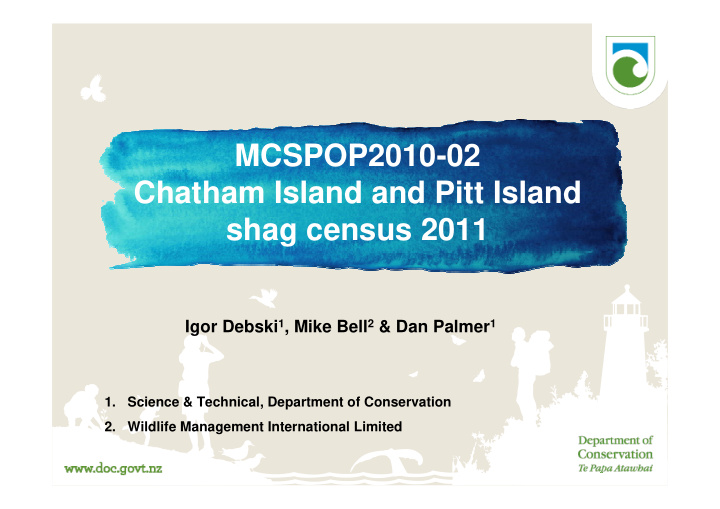



MCSPOP2010-02 Chatham Island and Pitt Island shag census 2011 Igor Debski 1 , Mike Bell 2 & Dan Palmer 1 1. Science & Technical, Department of Conservation 2. Wildlife Management International Limited
Objectives (a)conduct a complete recensus of Chatham Island and Pitt Island shags in such a way as to maximise comparability with earlier counts in order to determine any trend in population size; and (b) investigate the effects of timing and methodology on colony counts, and make recommendations for future monitoring of the populations of Chatham Island and Pitt Island shags.
Pitt Island shag Chatham Island shag
Methods • Followed the methods of Bell & Bell (2000) as closely as feasible in order to maximise the comparability with 1997/98 • Counted breeding pairs • Timed counts at incubation when maximum counts would be made • Extensive survey of all coast line suitable for shag nesting sites was conducted on 11 consecutive days, from 1 to 11 October 2011 (except 3 outlying islands) • Additional counts at sites where temporal variation known to be important • On foot and by boat • Also report results from a series of visits to breeding sites around main Chatham Island
Map of Chatham Islands showing census search effort
Example GPS plot of on foot search
Example GPS plot of boat search
Chatham Island shag breeding colonies Results
Pitt Island shag breeding areas
Chatham Island shag Cape Fournier Cape Pattisson 60 40 20 Incidentals Matarakau 60 40 20 Motuhinahina Island Ngatikitiki Rocks 60 40 20 Number of nests Okawa Point Okawa Point a 60 40 20 Okawa Point b Okawa Point c 60 40 20 Okawa Point d Point Weeding 60 40 20 Point Weeding b Wharekauri Island 60 40 20 JanFebMarAprMayJun Jul AugSepOct NovDec JanFebMarAprMayJun Jul AugSepOctNovDec Month Monthly counts for Chatham Island shags
Pitt Island shag Cape Fournier Cape Pattisson 30 20 10 Incidentals Little Awatotara Creek 30 20 10 Matarakau Motuhinahina Island 30 20 10 Number of nests Okawa Point Okawa Point 4 30 20 10 Okawa Point b Okawa Point c 30 20 10 Okawa Point d Point Weeding 30 20 10 Point Weeding b Wharekauri Island 30 20 10 Jan Mar AprMay Jun Jul AugSepOct NovDec Jan Mar AprMay Jun Jul AugSepOct NovDec Month Monthly counts for Pitt Island shags
Colony Colony Number er of nest of nests s Overa erall c l change 1 1997/9 /98 2003/0 /04 2011 Matarakau 53 35 27 Kaingaroa 0 1 0 Okawa Point 114 47 42 Cape Fournier 115 0 51 The Pinnacles 0 30 0 Ke Orea Point 7 4 3 Waitangi 6 5 19 Cape Pattison 0 11 5 Ngatikitiki 38 4 13 Cape Young 0 1 0 Motuhinahina 68 0 72 Chat Chatham Isl ham Island nd to total l 401 401 138 138 232 232 42% 42% declin ine e Motutapu Point 0 0 6 Kokepa Rock 0 15 0 Rabbit Island 83 20 18 North-eastern Reef 19 17 11 Star Keys 339 81 88 Pitt Isla tt Island and surround d surrounding ng isla islands tota s total l 441 133 133 23 23 72% 72% decline cline To Total l 8 842 2 271 271 355 355 58% % declin ine e Chatham Island shag census results
Compar arative br breedi ding area Nu Number o of n nests Overal all c chan ange 1 1997/9 /98 2003/0 /04 2011 Matarakau 3 11 0 Kaingaroa to Te Wakaru Island 29 32 62 Okawa Point 7 0 0 Owenga-Ko Orea Point 31 24 22 SW Coast 47 57 27 Waitangi 33 33 33 Red Bluff 6 9 10 Port Hutt Bays 0 0 1 Port Hutt 30 10 14 Point Somes South 19 21 7 Point Somes North 38 20 36 Ngatikitiki Rocks 18 9 3 Cape Young 68 14 62 Motuhinahina 11 7 12 Chatham I Ch ham Island nd tota total l 340 340 247 289 289 15 15% % decline cline Pitt Island North 55 54 28 Pitt Island East 32 36 0 Pitt Island South 49 43 15 Pitt Island West 6 11 2 Pitt tt I Isla land tota total l 142 144 45 68% decline 68% d cline Rabbit Island 29 18 6 Mangere incl. Little Mangere 23 19 15 Castle 6 14 11 Rangatira 63 45 10 Star Keys 46 43 12 Pitt tt I Island and and sur surround ounding isla ing islands s tot total l 309 309 283 3 99 68% decline 68% d cline 19 1997/ 97/98-201 8-2011 co compa mparative subtot ive subtotal 649 530 388 88 40% d 40 % decline cline 5 † Fourty Fours 9 4 41 † Sisters 71 9 0 † Western Reef 0 4 434 † Tot Total l 729 729 547 7 43 Pitt Island shag census results
Conclusions • Results represent a real declines in the populations, with no information to suggest such substantial numbers of breeding pairs may have been missed in 2011. • Greatest declines in population for both species at Pitt Island and offlying islands, including protected, predator- free sites. • Declines likely to be driven by at-sea factors, but lack of information on causal mechanisms.
Recommendations Future survey methods: • Counts should be timed to coincide with incubation at all colonies/breeding areas, recognising temporal variability. • Boat/on foot methods should be standardised for any one area. • Aerial photography is likely to be well suited for Chatham Island shags and should be trialled alongside ground counts.
Understanding causal factors: • Describe the nature and extent of direct fishing impacts (see INT2011-02). • Quantify demographic parameters and identify which are leading to the decline. • Describe the at-sea foraging habits (see proposed POP2012-08). • Quantify diet (see proposed POP2012-08). • Compare studies of the elements listed above between sites where colony trends differ (e.g. Motuhinahina vs Pitt Island area)
Recommend
More recommend